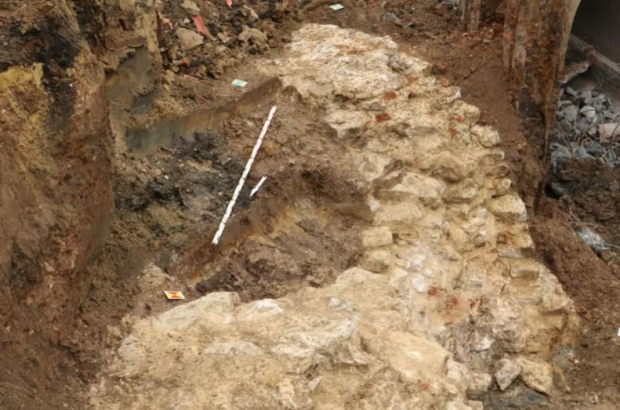- Daily & Weekly newsletters
- Buy & download The Bulletin
- Comment on our articles
Works on Brussels metro line turn up archaeological treasures
Construction work on Brussels’ new metro line 3 has turned up some interesting archaeological treasures.
The works have resulted in the uncovering of remnants of Brussels' second city wall, Bruzz reports, marking the first time that one of the approximately 70 semicircular towers of the second rampart wall has been uncovered.
Before this discovery, the only archaeological remains of the second city wall were a bastion wall from the 17th century, discovered during the construction of Porte de Hal metro station.
This new discovery, where the Boulevard du Midi meets Boulevard Stalingrad, near Brussels-Midi station, was made last year by archaeologists supervising the works, but the discoveries were recently reported in the journal Cahiers Bruxellois.
In addition to the tower remains, the archaeologists also found two "relatively parallel wall sections". Both finds were largely disturbed by modern developments, including a concrete opening on the west side and a brick sewer running right through it.
It was in the 14th century that both Brussels' economy and population boomed, forcing the city to expand and build a second wall.
Presumably, the difficulties encountered by the Count of Flanders and his troops defending the city in 1356 were the deciding factor for the laying of the foundation stone in 1357.
The perimeter of the second Brussels city wall was eight kilometres, making it twice as long as the first. The wall had some 70 semicircular towers, two round watchtowers, seven gates and two locks.
Although only the Porte de Hal remains, many references to the other gates can still be found in Brussels: the Porte de Namur, Porte de Louvain, Porte de Schaerbeek, Porte de Laeken, Porte de Flandre and Porte d'Anderlecht.
From each of these gates an important stone road left, such as the one to Ghent. An eighth gate, the Porte du Rivage, was built during the 16th century and allowed the canal, which connected the new Brussels inner port to the Rupel and Scheldt rivers, to flow into Brussels.
At the end of the 19th century, Brussels decided to make way (as in Paris) for a grand city boulevard, on which the people of Brussels could get around on foot or by horse. That decision changed the shape of many of the city’s neighbourhoods. New residential areas arose around the boulevard, and on the north and west sides the industrial zone expanded further due to the presence of the port.
Work on the metro line 3 is far from complete, meaning researchers expect more archaeological finds to turn up.
In the meantime, such gems are being discovered separately at a construction site on Rue Neuve, where frescoes appeared under the Celio shop.
There are about 10 of them, RTBF reports, most of them of Bruegelian inspiration and fairly well preserved despite having faded.
The first is set in a kitchen where several people in period clothing are preparing what appears to be a large meal. A proverb, in red and black, is clearly legible but incomplete: ‘Don't turn your oven into a bonnet, nor your…’, with the missing portion thought to have read ‘nor your stomach into a garden’.
The other frescoes feature a bird market, a bakery with its bakers, a fish market, a meat seller with his cow, Trappist monks brewing beer and blacksmiths.
Urban.brussels and its regional heritage service learned of the discovery through a Facebook post.
The administration will send an expert to the site next week to make a photographic report that will allow research to begin on the frescoes' age and origins.


















